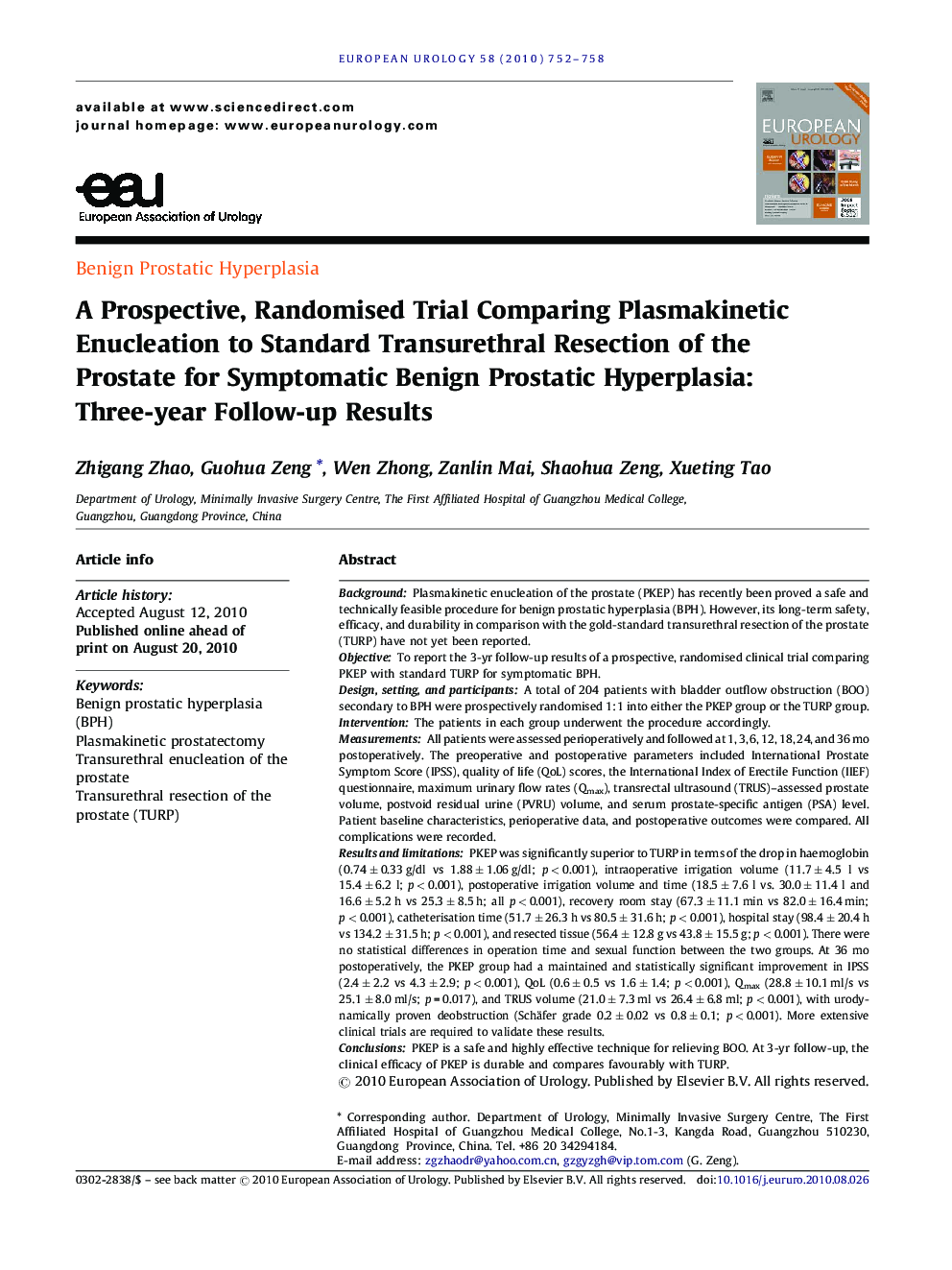| کد مقاله | کد نشریه | سال انتشار | مقاله انگلیسی | نسخه تمام متن |
|---|---|---|---|---|
| 3926252 | 1253145 | 2010 | 7 صفحه PDF | دانلود رایگان |

BackgroundPlasmakinetic enucleation of the prostate (PKEP) has recently been proved a safe and technically feasible procedure for benign prostatic hyperplasia (BPH). However, its long-term safety, efficacy, and durability in comparison with the gold-standard transurethral resection of the prostate (TURP) have not yet been reported.ObjectiveTo report the 3-yr follow-up results of a prospective, randomised clinical trial comparing PKEP with standard TURP for symptomatic BPH.Design, setting, and participantsA total of 204 patients with bladder outflow obstruction (BOO) secondary to BPH were prospectively randomised 1:1 into either the PKEP group or the TURP group.InterventionThe patients in each group underwent the procedure accordingly.MeasurementsAll patients were assessed perioperatively and followed at 1, 3, 6, 12, 18, 24, and 36 mo postoperatively. The preoperative and postoperative parameters included International Prostate Symptom Score (IPSS), quality of life (QoL) scores, the International Index of Erectile Function (IIEF) questionnaire, maximum urinary flow rates (Qmax), transrectal ultrasound (TRUS)–assessed prostate volume, postvoid residual urine (PVRU) volume, and serum prostate-specific antigen (PSA) level. Patient baseline characteristics, perioperative data, and postoperative outcomes were compared. All complications were recorded.Results and limitationsPKEP was significantly superior to TURP in terms of the drop in haemoglobin (0.74 ± 0.33 g/dl vs 1.88 ± 1.06 g/dl; p < 0.001), intraoperative irrigation volume (11.7 ± 4.5 l vs 15.4 ± 6.2 l; p < 0.001), postoperative irrigation volume and time (18.5 ± 7.6 l vs. 30.0 ± 11.4 l and 16.6 ± 5.2 h vs 25.3 ± 8.5 h; all p < 0.001), recovery room stay (67.3 ± 11.1 min vs 82.0 ± 16.4 min; p < 0.001), catheterisation time (51.7 ± 26.3 h vs 80.5 ± 31.6 h; p < 0.001), hospital stay (98.4 ± 20.4 h vs 134.2 ± 31.5 h; p < 0.001), and resected tissue (56.4 ± 12.8 g vs 43.8 ± 15.5 g; p < 0.001). There were no statistical differences in operation time and sexual function between the two groups. At 36 mo postoperatively, the PKEP group had a maintained and statistically significant improvement in IPSS (2.4 ± 2.2 vs 4.3 ± 2.9; p < 0.001), QoL (0.6 ± 0.5 vs 1.6 ± 1.4; p < 0.001), Qmax (28.8 ± 10.1 ml/s vs 25.1 ± 8.0 ml/s; p = 0.017), and TRUS volume (21.0 ± 7.3 ml vs 26.4 ± 6.8 ml; p < 0.001), with urodynamically proven deobstruction (Schäfer grade 0.2 ± 0.02 vs 0.8 ± 0.1; p < 0.001). More extensive clinical trials are required to validate these results.ConclusionsPKEP is a safe and highly effective technique for relieving BOO. At 3-yr follow-up, the clinical efficacy of PKEP is durable and compares favourably with TURP.
Journal: European Urology - Volume 58, Issue 5, November 2010, Pages 752–758